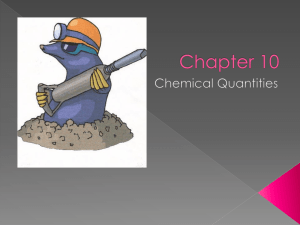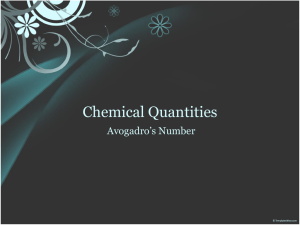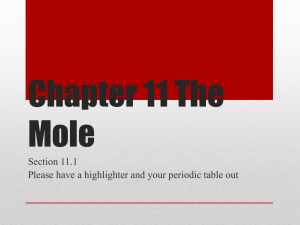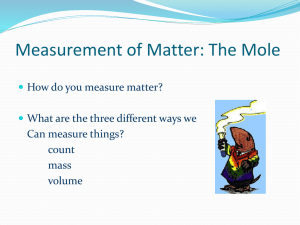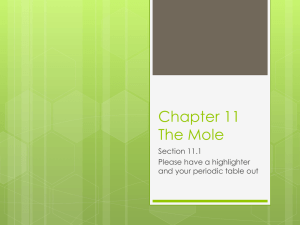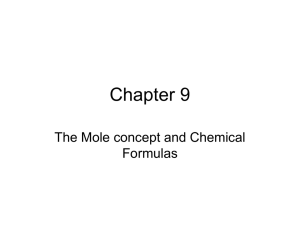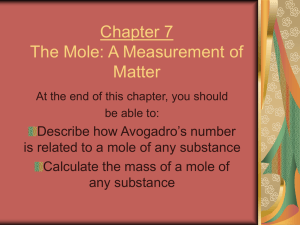Chapter 10.1 The Mole: A Measurement of Matter
advertisement
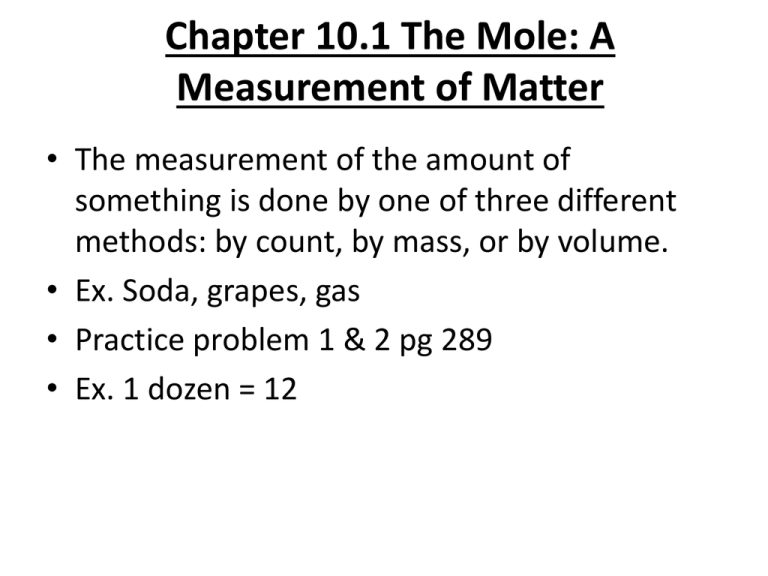
Chapter 10.1 The Mole: A Measurement of Matter • The measurement of the amount of something is done by one of three different methods: by count, by mass, or by volume. • Ex. Soda, grapes, gas • Practice problem 1 & 2 pg 289 • Ex. 1 dozen = 12 Chapter 10 10.1 The Mole: A Measurement of Matter • Chemist use a unit that is a specified unit of particles. This unit is called the mole. • Ex. 1 dozen = 12 • 1 mole = 6.02 x 1023 representative particles • Avagadro’s number is 6.02 x 1023 • A mole of any substance contains Avogadro’s number of representative particles, or 6.02 x 1023 representative particles. • Representative particles- refers to what is present in a substance; usually atoms, molecules, or formula units • When dealing with compounds representative particles are molecules. • When dealing with elements representative particles are atoms. Converting number of particles to moles: • moles = representative particles X ___ _ 1 mole_________ 6.02 x 1023 representative particles Converting moles to number of particles • representative particles = moles x 6.02 X 1023 representative particles 1 mole • Remember the atomic mass of an element is expressed in atomic mass units (amu) • Therefore 100 carbon atoms are 12 times heavier than 100 hydrogen atoms • The atomic mass of an element expressed in grams is the mass of a mole of the element. • Molar mass- The mass of a mole of an element. • Ex. Sulfur 32.06 amu Molar Mass = 32.1g The mass of a mole of a compound • To find the mass of a mole of a compound you must know the formula of the compound. • To calculate the molar mass of a compound, find the number of grams of each element in one mole of a compound. Then add the masses of the elements in the compound. • Ex. C6 H 1206 Chapter 10- 10.2 Mole-Mass and Mole Volume Relationships • Use the molar mass of an element or compound to convert between the mass of a substance and the mole of a substance. • • or • Mass(grams) = Number of moles x mass(grams) 1 mole Moles = mass(grams) x 1 mole Mass(grams) The Mole Volume Relationship • Avagadro’s hypothesis - states the equal volumes of gases at the same temperature and pressure contain equal number of particles. • Standard Temperature and Pressure (STP) - a temperature of 0 degrees Celsius, and pressure of 101.3 kPa, or 1 atmosphere (atm) • At STP, 1 mol or 6.02 x 1023 representative particles, of any gas occupies a volume of 22.4 L. • Molar volume of a gas is the quantity 22.4 L. Calculating Volume at STP • Volume of gas = moles of gas x 22.4 L 1 mol • Calculating Molar mass from Density • Grams = Mole Grams x 22.4 L L 1 mole 10.3 Percent Composition and Chemical Formulas • Percent composition- The relative amount of the elements in a compound • The percent by mass of an element in a compound, is the number of grams of the element divided by the mass in grams of the compound, multiplied by 100% • % mass of element = mass of element mass of compound X 100 Percent Composition from the Chemical Formula • % mass = mass of element in 1 mol compound X 100% Molar mass of compound Empirical Formula • Empirical formula- gives the lowest whole number ratio of the atoms of the elements in a compound. • The empirical formula of a compound shows the smallest whole number ratio of the atoms in a compound. • Ex. Sample problem pg. 310 Molecular Formulas • The molecular formula of a compound is either the same as its experimentally determined empirical formula, or it is a simple whole number multiple of its empirical formula. • Once the empirical formula is known, you can determine its molecular formula but you have to know the compounds molar mass • Sample problem pg.312


